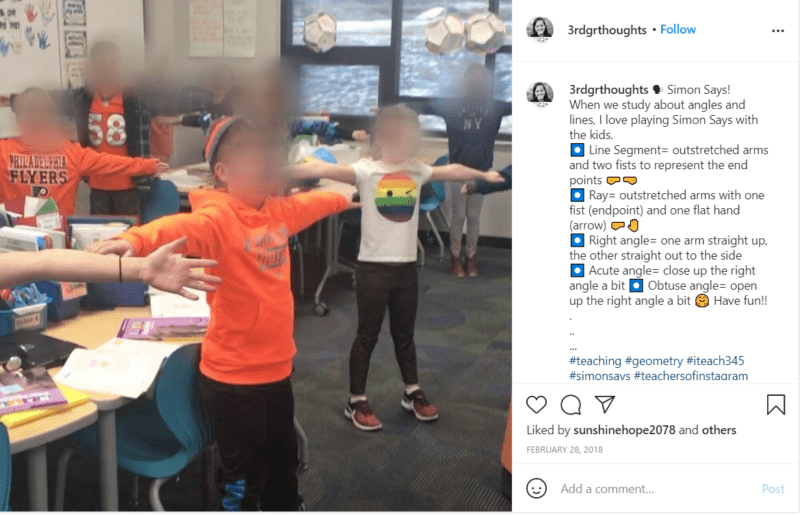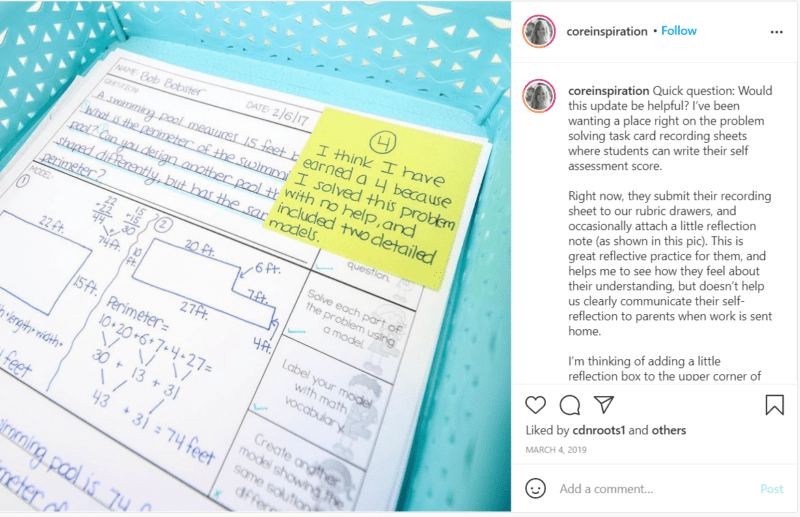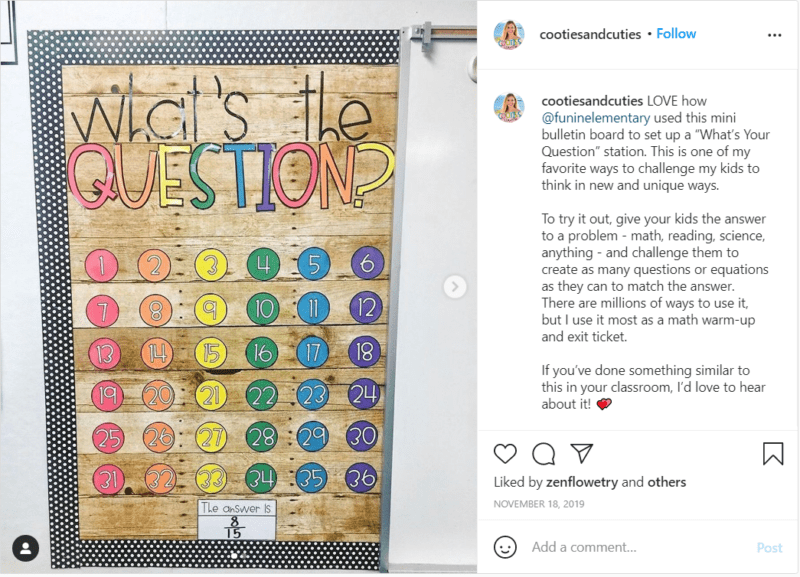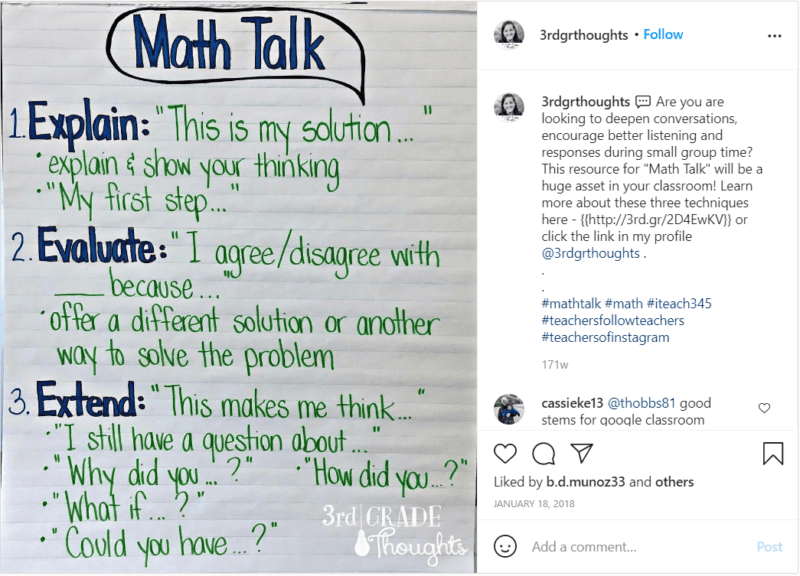Lesson Plans for 3rd Grade Reading Placement Assessments
If you were leading your course of third graders up the side of a mountain, you wouldn't hike all the way to the top without looking back to make sure everyone was still with you on the trail, right? Of course not. The same thinking applies in the classroom as well. That's why quick, regular formative assessments are essential. Are you covering material too chop-chop? Or too slowly? Do some students demand actress support? Understanding your students' learning enables you to teach finer and ensures each of your students succeeds. Go the feedback you need without breaking your stride with these third grade assessment ideas. Teaching remote? Don't worry, we've got ideas for remote learning assessments too!
Movement It!
Gauge educatee learning while besides giving your tertiary graders a chance to move and jerk.
i. Four Corners
Write possible answers on a whiteboard or employ the messages A, B, C, and D to designate spaces in each corner of the room. Next, read out a question and enquire students to motility to the corner that corresponds to their answer. Non only does Four Corners become students up and moving, but the speed at which students move toward the correct answer can tell you a lot most how confident they are in their answers. Besides, students who seem to exist tagging along with other students are likely to need additional support in mastering the concept. If information technology seems like too many students are following others, have each student write downward their reply before moving to the corner respective to their answer.
2. Simon Says
Are your students understanding the new math vocabulary you but covered? Accept them use their whole torso to show what they know through a game of Simon Says. Students in Stephanie's class (below) play Simon Says to review vocabulary related to lines and angles.

Source: @3rdgrthougts
Evidence It!
Gestures or visuals allow you lot to become a quick read on pupil agreement. They make the perfect third grade assessment strategies for your toolbox.
3. Colour Cards
A unproblematic deck of colored cards is an assessment tool you'll come dorsum to again and again throughout the twelvemonth. Create your own color cards by cut pieces of structure newspaper into 3" by 5" cards or utilize different colored alphabetize cards. Laminate the cards. Then hole punch them and bind them together on a binder band. Create a deck of cards for each student and have them keep their deck handy for quick check-in questions. For example, students can hold up a certain colour to testify their reply to a multiple choice question or they can use certain colors to signal how well they understand a topic, or equally a signal for assist from a teacher.
iv. Illustrated Ideas
Inviting students to illustrate a concept makes information technology piece of cake to do a quick visual check for understanding. As an added bonus, many students increase their understanding of a concept equally they piece of work through the stages from initial outline to a detailed finished illustration. This assessment can become a game of Quick Draw by using a timer to limit the corporeality of fourth dimension students accept to sketch out an idea. For example, students could illustrate a historical event after listening to a passage describing it, or draw out the stages in the life cycle of a frog, or represent a fraction every bit a shaded part of a whole.
five. Strive for Five
Share with students that learning is a procedure and as a community of learners, the class will work together to make sure everyone boosts their understanding from a aught (airtight fist) to a five (open paw). At the beginning of a lesson, during a lesson, and at the end of a lesson, ask students to show their level of understanding with their fingers. Creating an anchor chart like the one beneath tin can help students recollect the meaning of each number. Based on pupil responses, adapt your lesson program or grouping students together to provide additional support. Invite "level 5" students to assistance students at other levels. Celebrate educatee growth as students move from a zip to a five!
- 0 (closed fist) – I don't sympathise at all.
- one – I demand assistance.
- two – I need more examples and exercise.
- iii – I understand pretty well.
- 4 – I mostly empathize.
- 5 (open hand) – I completely sympathize.
Mark Information technology!
These assessment ideas make use of written/drawn responses, making them perfect for tranquillity times in the classroom.
6. Self-Assessment Sticky Notes
Simple, but effective. Give each student a sticky note and inquire them to reflect on their understanding of a task. Utilize an anchor chart to help students remember the dissimilar levels of mastery. This could be levels zero through five, or levels such equally Novice though Proficient. Proceed things consistent by using the aforementioned self-assessment system throughout the school year. At the end of a lesson or after completing an assignment, have students add a gluey note cocky-assessment to their work.

Source: @coreinspiration
vii. What'southward the Question?
A fun twist on the usual exit ticket, a "What's the Question?" wall invites students to create a question that matches the answer posted on the wall.

Source: @cootiesandcuties
Voice It!
Channel your students' love of talking with these oral cess ideas.
8. Interview the Learner
Divide students into pairs to conduct get out interviews about what they learned from a lesson or assignment. Share with students that effective interviewers desire to empathize the "why" of a story and hear virtually the procedure behind the learning. Provide students with question stems pertaining to the lesson, or invite them to interview each other about how their idea procedure changed over the course of the lesson (metacognition). Add actress fun to the interviews with toy microphones or microphones made from craft supplies.
Instance Interview Questions:
- What did nosotros exercise today in class?
- What did we larn about in class?
- At the beginning of class, what did you know most the topic? What is something you know now?
- Did you accept any "aha!" moments today? If so, what were they?
- What were some of the challenging parts of what we learned today?
- What questions do you nonetheless have?
- How might you lot apply what you lot learned?
9. Math Talks
Invite your 3rd graders to share their mathematical thinking with a partner as they explicate their solution to a math problem. Posting an ballast chart of math talk starter questions similar the ane below will assistance your students take constructive conversations. Listen in on individual pairs or ask pairs to share their thoughts with the course.

Source: Math assessments from @3rdgrthoughts
3rd Grade Assessment Ideas for Online Learning
Take reward of these simple video telephone call assessment ideas and helpful online tools to gauge student learning while teaching remotely.
10. Emoji Answers
Many third graders dear emojis, and so put them to work in your online classroom! Emoji responses tin can provide valuable insights into your course at a fourth dimension when it'south harder to become a read on students' facial expressions and trunk language. Ask students to choose an emoji showing how they felt during a recent lesson or assignment. Some teachers use emoji faces like "star eyes" to indicate mastery and "face with monocle" to indicate questions. Other teachers utilize weather emojis like a sun for "I understand clearly"; clouds for "I'm not quite clear/I'yard not sure I completed the assignment correctly"; and lightning for "I have questions/I need help."
Emojis can also exist used for short quizzes. For example, you could ask questions that tin can be answered with an emoji like, "What kind of animate being is Winn Dixie?" (Canis familiaris emoji) Or yous could display a multiple selection question using a unlike emoji to correspond each reply selection. Be certain to use emojis that are easily distinguishable from each other by shape or color and then it's like shooting fish in a barrel to understand student responses at a glance.
eleven. Text Me
When students summarize a concept, they have to capture the essential elements of what they've learned. This tin reveal a lot most what they've absorbed and understood. Enquire students to imagine they're texting a classmate who couldn't brand information technology to class today. How would they describe what was covered in course? What important details should the classmate know well-nigh the topic? Take students send yous their text messages through the class' online learning platform. Make up one's mind ahead of time whether you will allow slang and emojis as role of the message.
12. EdPuzzle Video Quizzes
EdPuzzle makes information technology like shooting fish in a barrel to turn whatsoever video into an interactive lesson that gives you feedback on student comprehension. Utilize videos from YouTube, Khan Academy, Crash Course, and more than or upload your own video. EdPuzzle enables teachers to add narration and questions for students.
For fifty-fifty more than great resources for didactics third course online, check out: Your Guide to Instruction Third Grade Online and Tips and Tools for Making Online Assessments Work.
What are your favorite third form cess ideas? Delight share in the comments or on our WeAreTeachers HELPLINE!
Source: https://www.weareteachers.com/third-grade-assessment/
0 Response to "Lesson Plans for 3rd Grade Reading Placement Assessments"
Post a Comment